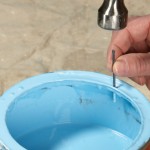 “My name’s Dan and I’m a recovering Prep Work Skipper.”
“My name’s Dan and I’m a recovering Prep Work Skipper.”
If there were support groups for those of us who consistently mess up paint jobs, that’s how I’d introduce myself every week.
See, I do a lot of things right when it comes to a paint job. I take the time necessary to pick the colors I really want (usually). I amass the necessary tools before I start. I buy quality materials and paint. I do many things right.
However, what I routinely screw up is this: I skip or skimp on the prep work. Every time. It’s like an addiction. An addiction to skipping prep work. I mean really, that’s got to be one of the dumbest sounding sentences I’ve ever written, but it’s the truth: I hate prep work when I paint and so I skip it. And then, inevitably (and by inevitably, I mean ALWAYS) it comes back to bite me. Inevitably (always).
And so I’m turning over a new leaf. From here on out I’m going to make the following changes to my painting methods and practices:
RESOLUTION NUMBER 1
I will no longer simply roll around or over the nails that are stuck in my wall. This usually messes up my roller, creating a weird divot that repeats over and over on my wall, frustrating me; or, it creates drips on the wall or floor that I don’t find until after the paint has dried. And that always makes me profoundly sad. From now on, I will remove those nails ahead of time.
RESOLUTION NUMBER 2
I will patch the nail holes left in my wall when I implement Resolution Number 1 above. And I will patch them with the proper spackling compound AND will let that compound DRY before I try to SAND it. (Because I’ve tried to rush this and sanding only partially dried spackling results in results that make me profoundly sad.) To give myself the proper time to accomplish these spackling and sanding tasks, I will have to tackle this aspect of the project ahead of the day that I plan to paint. This will require planning and discipline, and I resolve to practice both.
RESOLUTION NUMBER 3
I will no longer tell myself that my walls are clean enough and do not need to be wiped down before I paint. I will accept the fact that I do not regularly clean the top corners of every room and that even though I style myself as a clean and tidy person, there is a good chance that random cobwebs may be there. I will take the necessary 20 minutes to wipe away those cobwebs so I don’t end up rolling into them later with paint and then spreading them over my walls.
RESOLUTION NUMBER 4
I will no longer let myself believe that “scuff sanding” is a great idea, but that I really don’t have time to do it right now. I will take the necessary 10 minutes to scuff sand a dresser before I prime and paint it. I will scuff sand my woodwork before I paint it. I will scuff sand all shiny surfaces EVEN IF I’m using a primer that says “no scuff sanding necessary.” I will remember that there are no shortcuts.
RESOLUTION NUMBER 5
I will no longer do everything else right–buy the right paint, buy the best tools, choose the right colors–only to screw the project up by skipping the prep work. I will admit that an extra hour or two is worth all the extra work and frustration and money I’ve cost myself through the years by skipping prep work. I will do the proper prep work, no matter how boring it is, so that my project looks as professional as possible when I finish. In short, I will no longer convince myself that certain prep-work projects are worthwhile, but that I simply don’t have time for them. I will make time for prep work precisely because it is so worthwhile.
Those are my resolutions. I’ll probably screw up from time to time, but I’m going to give it my best shot from here on out. How about you? Anyone else out there who routinely skips the prep work stage only to be burned in the end? Anyone else out there ready to circle up, admit your addiction to hating prep work, and start the recovery process? The recovery group is open….



 I’m cheap. I’ve probably written that before, but that doesn’t matter. I’m so cheap, it’s legitimate to write it again. But that cheapness has it’s limits.
I’m cheap. I’ve probably written that before, but that doesn’t matter. I’m so cheap, it’s legitimate to write it again. But that cheapness has it’s limits.
 Not too long ago, we purchased a portable basketball hoop for the kids. We figured we’d all have fun shooting hoops and doing all that “basketball stuff” in our driveway. I assumed it would be a great bonding time, would provide some excercise, and, above all, give us something to do outside.
Not too long ago, we purchased a portable basketball hoop for the kids. We figured we’d all have fun shooting hoops and doing all that “basketball stuff” in our driveway. I assumed it would be a great bonding time, would provide some excercise, and, above all, give us something to do outside.
 Once upon a time, probably about 6 years ago or so, my wife and I walked with our kids to the Zeeland Bakery. Caleb (who was 5 at the time) waited outside with me while my wife and the other kids sauntered into the shop and ordered various donuts and cookies and different types of bread. (It’s always a huge undertaking whenever we go to the bakery).
Once upon a time, probably about 6 years ago or so, my wife and I walked with our kids to the Zeeland Bakery. Caleb (who was 5 at the time) waited outside with me while my wife and the other kids sauntered into the shop and ordered various donuts and cookies and different types of bread. (It’s always a huge undertaking whenever we go to the bakery).
 Have you ever noticed that when you’re sick, everybody is suddenly a doctor. Everyone has an opinion and a cure for what ails you. And while some of the cures are very common–chicken soup cures, we could call them–others are anything but.
Have you ever noticed that when you’re sick, everybody is suddenly a doctor. Everyone has an opinion and a cure for what ails you. And while some of the cures are very common–chicken soup cures, we could call them–others are anything but. a paint storage tip. It’s actually a painting application tip, but I’m including it here because it can radically affect your ability to store paint when you finish the job.
a paint storage tip. It’s actually a painting application tip, but I’m including it here because it can radically affect your ability to store paint when you finish the job. The second method I’d like to address is the common Store the Paint Can Upside Down method. The theory behind this concept is that air will leak in through the lid. If you turn the can upside down, the air will not be able to sneak in and therefore, your paint will stay good longer.
The second method I’d like to address is the common Store the Paint Can Upside Down method. The theory behind this concept is that air will leak in through the lid. If you turn the can upside down, the air will not be able to sneak in and therefore, your paint will stay good longer. then Pound the Lid on method. This is supposed to create an extra seal between the rim and the lid and prevent air from seaping into the can.
then Pound the Lid on method. This is supposed to create an extra seal between the rim and the lid and prevent air from seaping into the can.
 The other night, we–my family and I–were sitting in the living room, watching the Tigers. The kids were running around, driving us a little nuts and eventually there came a point when I stood up and put my hands on my hips. (Which really, is something I wish I didn’t do because my wife and kids always mock me and laugh and say that I think I’m a Super Hero. Which I don’t, the picture below notwithstanding. I just happen to stand like one.)
The other night, we–my family and I–were sitting in the living room, watching the Tigers. The kids were running around, driving us a little nuts and eventually there came a point when I stood up and put my hands on my hips. (Which really, is something I wish I didn’t do because my wife and kids always mock me and laugh and say that I think I’m a Super Hero. Which I don’t, the picture below notwithstanding. I just happen to stand like one.)